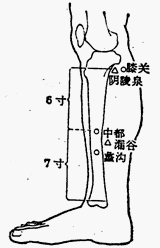bubble_chart Etymology "Xi" (膝), knee; "guan" (關), joint. The acupoint is located near knee joint, hence the name.
bubble_chart Location
On the inner side of calf, posterior and inferior to medial condyle of tibia, in the upper part of medial head of gastrocnemius muscle, in the depression one cun posterior to
Yinlingquan (SP9).
- Zhenjiu Jiayi Jing: "Two cun below Dubi (ST35), in the depression";
- Beiji Qianjin Yaofang "Three cun",
- Zhenjiu Juying as "Two cun beside";
- Zhenfang Liuji: "In the depression on the inner side below kneecap, level with Dubi (ST35), two cun apart";
- Donggong Anmo Mijue: "In the depression beside Dubi (ST35), below kneecap";
- Zhenjiu Jicheng: "Directly below Zhongdu (LR6), five cun apart." According to the positioning methods in Zhenjiu Juying, Zhenfang Liuji, and Donggong Anmo Mijue, this point corresponds to Neixiyan (EX-LE4), located in the depression on the inner side of patellar ligament.
bubble_chart Anatomy
- Muscle: gastrocnemius.
- Nerve: medial sural cutaneous nerve; deepest layer, tibial nerve.
- Vessel: posterior tibial artery.
bubble_chart Manipulation
Perpendicular insertion is 1 to 1.5 cun, Moxibustion with moxa cone is 3 to 5 cun, moxibustion is warm moxibustion for 5 to 10 minutes.
bubble_chart Efficacy
- Classical: knee pain preventing flexion and extension, cold-dampness wandering pain, weakness and numbness of lower limbs, multiple arthralgia pain, sore throat.
- Modern: gout.
bubble_chart Combinations
- Redness, swelling and pain in both knees: Yinshi (ST33), Xiguan (LR7), Weizhong (BL40), Sanli.
bubble_chart Other Related Items
